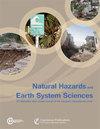评论文章:亚洲高山的冰雪雪崩——科学的、地方的和土著的知识
IF 4.7
2区 地球科学
Q1 GEOSCIENCES, MULTIDISCIPLINARY
引用次数: 4
摘要
摘要亚洲高山冰冻圈(HMA)不仅通过其储水能力维持下游居民的生计,而且还具有潜在的危害。由于缺乏长期观测、难以接近、恶劣天气条件以及财政和后勤限制,人们对气候与潜在触发因素之间的复杂关系知之甚少,因此迄今为止对其中一种灾害——雪崩的研究仍不充分。在本研究中,回顾了从20世纪末到2022年6月的现有文献,以确定研究和社会差距,并提出未来的研究方向和缓解战略。除了科学文献外,还参考了技术报告、报纸、社交媒体和其他当地来源,编制了一个全面、开放获取和版本控制的雪崩事件及其相关影响数据库。该地区8个国家共发生681起雪崩,造成3131人死亡。阿富汗的雪崩死亡人数最多(1057人),其次是印度(952人)和尼泊尔(508人)。此外,564人在攀登海拔4500米以上的山峰时丧生。其中三分之一是导游或搬运工。这使得它的致命危险比人口较少的欧洲阿尔卑斯山要小,但受影响的人数要多得多,他们不是自愿冒雪崩的风险的。虽然死亡人数巨大,雪崩对当地的长期影响可能相当大,但到目前为止,该地区的整体适应或缓解措施有限。这些措施一般依赖于适应现代技术的地方和本土知识。考虑到雪崩对该地区的高影响,我们建议进一步制定适应措施,包括基于历史事件数据集和建模工作的危险分区图。然而,这应该在承认该地区已有知识的基础上进行,并与社区、地方政府和民间社会利益攸关方密切协调。还应尝试进行更多的研究,以了解该地区雪崩的趋势和驱动因素。本文章由计算机程序翻译,如有差异,请以英文原文为准。
Review article: Snow and ice avalanches in high mountain Asia – scientific, local and indigenous knowledge
Abstract. The cryosphere in high mountain Asia (HMA) not only sustains the livelihoods of people residing downstream through its capacity to store water but also holds the potential for hazards. One of these hazards, avalanches, so far remains inadequately studied, as the complex relationship between climate and potential triggers is poorly understood due to lack of long-term observations, inaccessibility, severe weather conditions, and financial and logistical constraints. In this study, the available literature was reviewed covering the period from the late 20th century to June 2022 to identify research and societal gaps and propose future directions of research and mitigation strategies. Beyond scientific literature, technical reports, newspapers, social media and other local sources were consulted to compile a comprehensive, open-access and version-controlled database of avalanche events and their associated impacts. Over 681 avalanches with more than 3131 human fatalities were identified in eight countries of the region. Afghanistan has the highest recorded avalanche fatalities (1057), followed by India (952) and Nepal (508). Additionally, 564 people lost their lives while climbing peaks above 4500 m a.s.l., one-third of which were staff employed as guides or porters. This makes it a less deadly hazard than in the less populated European Alps, for example, but with a considerably larger number of people affected who did not voluntarily expose themselves to avalanche risk. Although fatalities are significant, and local long-term impacts of
avalanches may be considerable, so far, limited holistic adaptation or
mitigation measures exist in the region. These measures generally rely on
local and indigenous knowledge adapted to modern technologies. Considering
the high impact avalanches have in the region, we suggest to further develop adaptation measures including hazard zonation maps based on datasets of historic events and modelling efforts. This should, however, happen acknowledging the already existing knowledge in the region and in close coordination with communities, local government and civil society stakeholders. More research studies should also be attempted to understand the trends and drivers of avalanches in the region.
求助全文
通过发布文献求助,成功后即可免费获取论文全文。
去求助
来源期刊
CiteScore
7.60
自引率
6.50%
发文量
192
审稿时长
3.8 months
期刊介绍:
Natural Hazards and Earth System Sciences (NHESS) is an interdisciplinary and international journal dedicated to the public discussion and open-access publication of high-quality studies and original research on natural hazards and their consequences. Embracing a holistic Earth system science approach, NHESS serves a wide and diverse community of research scientists, practitioners, and decision makers concerned with detection of natural hazards, monitoring and modelling, vulnerability and risk assessment, and the design and implementation of mitigation and adaptation strategies, including economical, societal, and educational aspects.

 求助内容:
求助内容: 应助结果提醒方式:
应助结果提醒方式:


